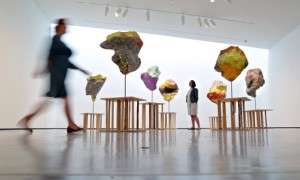
Showing the Austrian maverick at the temple to Britain’s greatest female sculptor reveals what a complex and joyous artist he was.
If you stand among Barbara Hepworth‘s carved and rounded plaster and wood shapes at the Hepworth in Wakefield for long enough, you feel that time will wear a hole right through you. Hepworth’s art seemed to aim for a kind of timelessness. But time is all I feel among these soothing shadows and hushed planes. I feel eroded in their presence.
Among these prototypes for her bronzes sit three rough, crumbly hollow lumps. The invigilators might want to keep an eye on them. They look like they’ve wandered in, up to no good, slack-mouthed and conspiring. Franz West’s uncouth papier-mâché forms are a great counterpoint to the reserve and sanded-down refinement of Hepworth.
Part of an excellent survey of the late Austrian artist’s work that has travelled to Wakefield from Frankfurt and Vienna, West’s 1988 ensemble Das Geraune (Murmuring) is the only work at the Hepworth placed in direct relationship to the British modernist. Where Hepworth’s art encourages a sort of mute contemplation, West’s is all about how objects speak and have their way with us. His sculpture, objects and collaborations with other artists feel part of the world rather than apart from it. “It doesn’t matter what the art looks like but how it’s used,” West said.
